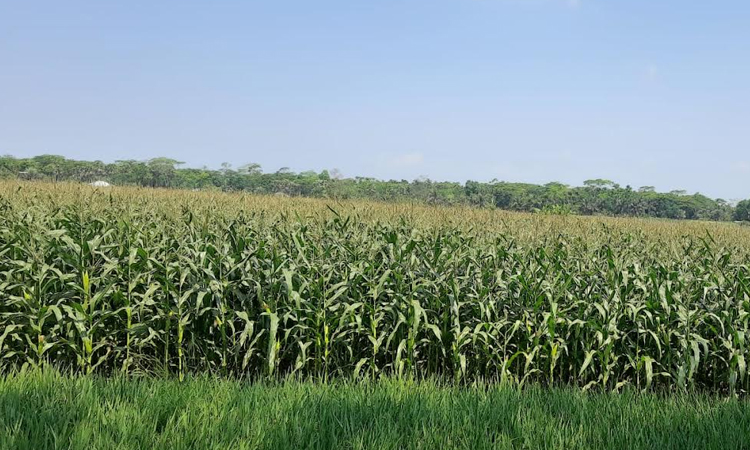News Flash
News Flash

By Azad Ruhul Amin
BAGERHAT, April 18, 2025 (BSS) - Kachua upazila in the district has seen a
bumper maize harvest this year, bringing a wave of enthusiasm among local
farmers, especially as maize gains importance as a key ingredient in fish
feed.
With its lower production costs compared to rice and a higher market price,
maize-- often dubbed the "golden grain"-- are quickly becoming the crop of
choice for many. Its growing popularity marks a promising shift in
agricultural trends across the region, said officials of Upazila Agriculture
Office.
They said maize has become an essential feed for fish, driving up its demand.
As a result, hundreds of fish farmers in the region are now growing maize for
their own use and selling the excess in local markets.
This year, maize has been cultivated on 145 hectares of land in Kachua, an
increase of 15 hectares from the previous year. The crop is widely grown in
the Shialkathi, Chotoboga, and Madartala areas of the upazila.
According to the Bangladesh Agricultural Research Institute, maize can be
grown twice a year-- during the Rabi and Kharif seasons. Maize sowing
typically occurs from October to November for the Rabi season while between
February 15 and March 30 for the Kharif season.
The crop takes about 125-130 days to mature in the Rabi season, and 80-90
days in the Kharif season. Average yields per hectare are around 3.5-4.0
tonnes during Rabi, and 2.5-3.5 tonnes during Kharif.
Maize sales have surged across Kachua, reflecting its profitability. The
entire plant is useful: green leaves serve as cattle fodder, stalks are used
as fuel, and husks and other residues are also sold. These by-products help
farmers recoup cultivation costs.
While talking to farmers, they said that maize cultivation on one acre of
land costs approximately Taka 17,000, with an average yield of 30 kilograms
per 100 decimal. The crop is sold at Taka 1,300-1,400 per maund.
Md. Sabur Sheikh, a farmer from Madartala village in Gojalia Union of the
upazila, told BSS that last year he earned Taka one lakh from one acre of
maize. This year, he expanded cultivation by an additional 50 decimals and
expects to earn Taka 2.5 lakh.
He said maize is a viable alternative to costly fish meal and has started
drying and storing his own maize for use in his fisheries.
Another farmer Nurul Islam Sikder of Madartala said he earned Taka 74,000
last year from maize grown on 74 decimals. This year, he has expanded
cultivation to 1.5 acres and hopes to earn at least Taka 80,000 more. He
credited the higher yield to fewer pest attacks and improved irrigation.
Farmer Shafayet Hossain, also from Madartala, said he sold his maize crop at
Taka one lakh last year. This season, he is optimistic about increasing
earnings by an additional Taka 75,000.
Maize is marketed across several areas including Fatepur, Jatrapur, Nazirpur,
Baburhat and Khezur Tola in Bagerhat along with Kachua, Gojalia, Badhal and
Bhasha.
Buyers also visit farms directly to purchase the produce. Even before
harvest, green maize leaves are sold for use as cow fodder, and dried stalks
are in demand as fuel - ensuring no part of the crop goes to waste.
Tushar Kanti Saha, deputy assistant agriculture officer for Gojalia Union,
stated that although there was no direct government incentive for maize
cultivation this year, the Upazila Parishad (UP) distributed seeds to 120
farmers. Despite limited support, maize farming expanded significantly, he
said.
The Department of Agricultural Extension (DAE) has been providing continuous
technical guidance throughout the cultivation process, he added.
Akash Bairagi, agriculture officer of Kachua upazila, said maize requires
significantly less irrigation than paddy. Last year, maize worth Taka 3.5
crore was sold in Kachua and this season, sales are expected to surpass at
Taka 4.5 crore, he added.